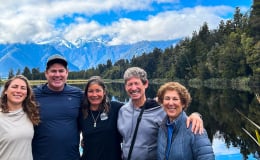
Exploring the Coromandel Coast

The Coromandel Coast is the real calling card of the North Island, the absolute opposite of a bustling city. Native rainforest draped over craggy white cliffs and 400km of white sand beaches mean the Coromandel Peninsula is the place to go when you want to escape, switch off and embrace nature, sunshine and an alternative lifestyle. One of our favourite things about the Coromandel Coast is the vibrant arts scene that thrives here. Hahei is one of our favourite spots to check out. The locals live life at a different pace here and for that reason, it’s a favourite holiday spot for Kiwis. This is your guide to the Coromandel Coast.
Top things to do along the Coromandel Coast
Hang out in Hahei
Hahei is the little ‘town’ you can’t miss. Whether you’re a scuba diver, a sea kayaker or a sun-bather, the area of Hahei and Mercury Bay is the place to go to spend time in or on the water. Home to both Cathedral Cove and the famed Hot Water Beach, as well as art galleries, gift shops, cafés and restaurants galore, it’s a great little place to spend a day exploring!
Cathedral Cove
All it takes is a quick Google image search to convince you of the merits of Cathedral Cove. This slice of paradise on the Coromandel Peninsula is part of the Te Whanganui-A-Hei Marine Reserve. The best way to experience this gem is by boat or kayak (on our Sweet North tour we take you there by kayak).

Gorgeous from all angles - Cathedral Cove on the Coromandel Coast is the sweetest of spots.
Hot Water Beach
This unique spot showcases an experience you won’t find in too many other places in the world. Timing is everything as you have two hours on either side of low tide to dig a pit and unwind in your very own natural spa pool in the sand. It is rated as one of the world's most renowned beaches!
The Pinnacles
For a multi-day hike (or day-long for the intrepid), we recommend checking out the Pinnacles. It’ll take roughly eight hours to complete in one day, or spread it out over two days and have a downright Kiwi experience by spending a night in a backcountry hut. The latter is a great opportunity to experience sunset and sunrise in the mountains. The route follows that of the packhorses who carried the kauri loggers’ supplies back in the early1900s. It’s a truly special place, filled with native nikau palms and huge rata trees. From the summit, you will look out across the Pacific Ocean to the offshore islands of the Coromandel and the Bay of Plenty.
Coromandel Coastal Walkway
Another option for a walk is the 10km return Coromandel Coastal Walkway. Take in views of the craggy coastline from the land as you walk beneath giant Pohutukawa trees. Choose to start in either Fletcher Bay or Stony Bay. There are both guided and shuttle services available from Coromandel Town. There is also an 8km return mountain bike trail running alongside the coastal walkway.

The glorious Coromandel coast.
Best time to visit the Coromandel Coast
The beauty of New Zealand’s North Island is that it’s not subjected to a harsh winter like the South Island. Therefore, the Coromandel Peninsula can be visited year-round. In saying that, we recommend a spring or autumn trip when the days are still long and warm and the majority of the crowds have dissipated. In the height of the summer, temperatures average around 24 - 31°C. In the winter they hover between 12 - 14°C.

Explore the Coromandel by kayak on our Sweet North trip.
Our trips
On our Sweet North tour, you will tick off many of the Coromandel Coast highlights. After arriving in Auckland, we’ll head straight to the Coromandel Peninsula. There, we’ll begin our adventure by stretching our legs on the Waiomu Kauri Walk. This walkway travels through native forest to a grove of ancient kauri trees. After that, it’s time to relax with a trip to Hot Water Beach where, if we’re lucky, we’ll be able to dig a small pool and enjoy a DIY spa! After checking out this beautiful beach, we’ll travel to our accommodation in Whitianga. On day two of your trip, we’ll travel along the Coromandel coastline to Hahei. There, we’ll paddle through surreal turquoise waters out to Cathedral Cove to see the incredible natural rock archway.
If you want to find out more about the incredible 5-14 day hiking tours we run in New Zealand, you can request a free copy of our brochure here.







